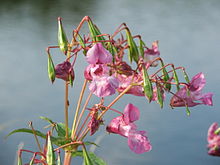Therophyte

The glandular balsam : a therophyte
Therophytes ( ancient Greek θέρος théros 'summer, summer heat, warmth' and φυτόν phyton 'plant') are herbaceous plant species with a short lifespan that survive an unfavorable season (winter or dry season) as seeds in the soil. The term was coined in 1905 by Christen Raunkiær .
Therophytes exist as annual or biennial plants . The seeds are very cold-resistant due to their very low water content.
Corn poppy ( Papaver rhoeas ) is an example of this type of life. Corn poppy usually occurs every two years ( winter annual ), but can also occur one year ( summer annual ).
Annual therophytes are often found as part of ruderal vegetation .
See also
Individual evidence
- ↑ a b Gerhard Wagenitz : Dictionary of Botany. Morphology, anatomy, taxonomy, evolution. With English-German and French-German registers . 2nd expanded edition. Nikol, Hamburg 2008, ISBN 978-3-937872-94-0 , pp. 328 (licensed edition 2003).
- ^ Andreas Bresinsky , Christian Körner , Joachim W. Kadereit , Gunther Neuhaus , Uwe Sonnewald : Textbook of Botany . Founded by Eduard Strasburger . 36th edition. Spektrum Akademischer Verlag, Heidelberg 2008, ISBN 978-3-8274-1455-7 , p. 168 .